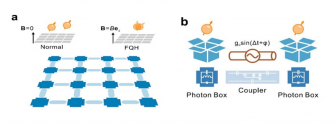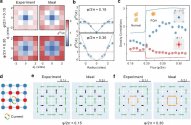Since origin quantum made its Wukong superconducting quantum computer has been visited 5 million times globally4月15日消息,本源量子公司宣布,其最新研发的“本源悟空”超导量子计算机自面世以来全球访问量已超过500万次。
You are using an out of date browser. It may not display this or other websites correctly.
You should upgrade or use an alternative browser.
You should upgrade or use an alternative browser.
Quantum computing thread
- Thread starter tphuang
- Start date
China's first 500+ qubit machine now getting sent to Quantum CTek for validation
wukong quantum computing continues to see more action. It is also not being placed for usage alongside Wuhu computing cluster. Another super computer center that it is paired up in.
Professor Pan Jianwei and Team done it again ..
According to the News Network of the University of Science and Technology of China, Professors Pan Jianwei, Lu Chaoyang, Chen Mingcheng and others from the school have achieved nonlinearity between photons using an independently developed Plasmonium (plasma transition type) superconducting high anharmonic optical resonator array. Interaction, and further constructed an equivalent magnetic field acting on photons in this system to construct an artificial gauge field, and realized the fractional quantum anomalous Hall state of photons for the first time in the world. This is an important progress in using "bottom-up" quantum simulation methods to conduct research on quantum states of matter and quantum computing. The relevant results were published in the form of a long article in the international academic journal "Science" on May 3, Beijing time..
raditional experimental research on the quantum Hall effect adopts a "top-down" approach, that is, based on a specific material, the existing structure and properties of the material are used to prepare the quantum Hall state. Usually, an extremely low temperature environment, extremely high purity of two-dimensional materials and an extremely strong magnetic field are required, which imposes strict experimental requirements. In addition, the traditional "top-down" method is difficult to independently control and measure the microscopic quantum state of the system at a single point, which limits its application in quantum information science to a certain extent.

In contrast, artificially built quantum systems have clear structures, are flexible and controllable, and are a new paradigm for "bottom-up" research on complex quantum states of matter. Its advantages include: no external magnetic field is required, and the equivalent artificial gauge field can be constructed by transforming the coupling form; through high-precision addressable control of the system, comprehensive measurement of the microscopic properties of the highly integrated metrology subsystem can be achieved, and Further controllable utilization . This type of technology is called quantum simulation and is an important part of the "second quantum revolution" . It is expected to be used in the near future to simulate quantum systems that are difficult to perform classical calculations and achieve "quantum computing superiority."

In order to solve this major challenge, the team independently developed and named a new type of superconducting qubit Plasmonium in the world, which broke the constraints between the coherence and anharmonicity of the current mainstream Transmon (transmission subtype) qubit. Higher anharmonicity provides stronger repulsion between photons. Furthermore, the team constructed an equivalent magnetic field acting on photons through AC coupling, so that the flow of photons around the crystal lattice can accumulate Berry phases, solving two key problems in realizing the photon fractional quantum anomalous Hall effect. At the same time, such an artificial system has the advantages of addressability, independent control and reading of single points, and strong programmability, providing new means for experimental observation and manipulation.
In this work, the researchers observed the unique topological correlation properties of the fractional quantum Hall state and verified the fractional Hall conductance of the system. At the same time, they tracked the generation process of quasiparticles by introducing a local potential field and confirmed the incompressible nature of quasiparticles.
The reviewer of "Science" magazine spoke highly of this work and believed that this work " is a major progress in quantum simulation using interacting photons " and "a novel local single-point control and bottom-up approach", "It has the potential to open a new way to achieve non-Abelian topological states, which are difficult to detect using traditional methods using two-dimensional electron gas materials."
@tphuang @FairAndUnbiased @BoraTas ..
One of the Holy Grails of Quantum Simulation"! Chinese scientists realize fractional quantum anomalous Hall state of photons
According to the News Network of the University of Science and Technology of China, Professors Pan Jianwei, Lu Chaoyang, Chen Mingcheng and others from the school have achieved nonlinearity between photons using an independently developed Plasmonium (plasma transition type) superconducting high anharmonic optical resonator array. Interaction, and further constructed an equivalent magnetic field acting on photons in this system to construct an artificial gauge field, and realized the fractional quantum anomalous Hall state of photons for the first time in the world. This is an important progress in using "bottom-up" quantum simulation methods to conduct research on quantum states of matter and quantum computing. The relevant results were published in the form of a long article in the international academic journal "Science" on May 3, Beijing time..
raditional experimental research on the quantum Hall effect adopts a "top-down" approach, that is, based on a specific material, the existing structure and properties of the material are used to prepare the quantum Hall state. Usually, an extremely low temperature environment, extremely high purity of two-dimensional materials and an extremely strong magnetic field are required, which imposes strict experimental requirements. In addition, the traditional "top-down" method is difficult to independently control and measure the microscopic quantum state of the system at a single point, which limits its application in quantum information science to a certain extent.

In contrast, artificially built quantum systems have clear structures, are flexible and controllable, and are a new paradigm for "bottom-up" research on complex quantum states of matter. Its advantages include: no external magnetic field is required, and the equivalent artificial gauge field can be constructed by transforming the coupling form; through high-precision addressable control of the system, comprehensive measurement of the microscopic properties of the highly integrated metrology subsystem can be achieved, and Further controllable utilization . This type of technology is called quantum simulation and is an important part of the "second quantum revolution" . It is expected to be used in the near future to simulate quantum systems that are difficult to perform classical calculations and achieve "quantum computing superiority."

In order to solve this major challenge, the team independently developed and named a new type of superconducting qubit Plasmonium in the world, which broke the constraints between the coherence and anharmonicity of the current mainstream Transmon (transmission subtype) qubit. Higher anharmonicity provides stronger repulsion between photons. Furthermore, the team constructed an equivalent magnetic field acting on photons through AC coupling, so that the flow of photons around the crystal lattice can accumulate Berry phases, solving two key problems in realizing the photon fractional quantum anomalous Hall effect. At the same time, such an artificial system has the advantages of addressability, independent control and reading of single points, and strong programmability, providing new means for experimental observation and manipulation.
In this work, the researchers observed the unique topological correlation properties of the fractional quantum Hall state and verified the fractional Hall conductance of the system. At the same time, they tracked the generation process of quasiparticles by introducing a local potential field and confirmed the incompressible nature of quasiparticles.
The reviewer of "Science" magazine spoke highly of this work and believed that this work " is a major progress in quantum simulation using interacting photons " and "a novel local single-point control and bottom-up approach", "It has the potential to open a new way to achieve non-Abelian topological states, which are difficult to detect using traditional methods using two-dimensional electron gas materials."
@tphuang @FairAndUnbiased @BoraTas ..
Last edited:
Over 100 million yuan in financing! Domestic quantum computing company completed Pre-A round of financing and emerged from Tsinghua University!
Recently, Huayi Boao (Beijing) Quantum Technology Co., Ltd. (abbreviation: Huayi Quantum) announced the completion of Pre-A round financing of over 100 million yuan, led by CCTV Media Fund, Baidu Venture Capital, Lenovo Venture Capital and Sanqi Venture Capital Interactive Entertainment participated in this round of investment. This financing will accelerate the research and development of Huayi Quantum’s new ion trap quantum computer, the expansion of new business scenarios, and the exploration of quantum algorithm applications in more industries.
Huayi Quantum is an enterprise dedicated to the field of quantum computing. It was born out of the Quantum Information Center of Tsinghua University and co-founded by the quantum information research team of the Interdisciplinary Information Institute of Tsinghua University. Its founder is Professor Duan Luming, an academician of the Chinese Academy of Sciences, and its chairman, Dr. Yao Lin, has rich research experience at Tsinghua University and Brookhaven National Laboratory in the United States.It is reported that Professor Duan Luming is not only an academician of the Chinese Academy of Sciences, but also an internationally renowned quantum information expert. He also serves as the director of the Quantum Information Center, Basic Science Chair Professor and Yao Qizhi Chair Professor of Tsinghua University.
In addition, the core team of Huayi Quantum brings together more than ten PhDs and postdocs from the School of Interdisciplinary Information at Tsinghua University, covering multiple professional fields such as quantum mechanics, optics, vacuum, and algorithms.The founding team of Huayi Quantum has made major breakthroughs in a number of key technologies in the development of large-scale quantum computers, including continuously setting world records in terms of the number of trapped ions.Huayi Quantum focuses on the ion trap quantum computing route. According to its official website, the company's business covers large-scale universal ion trap quantum computers, quantum cloud services, customized ion trap systems, supporting experimental equipment, etc.
On April 27, 2023, Huayi Quantum officially released the first-generation commercial prototype of ion trap quantum computing, HYQ-A37, which can provide quantum computing capabilities of up to 37 qubits and realize programmable universal quantum logic gate sets and Adiabatic quantum calculations.
SCMP is a blatant Lier.
there is no such a statement from Chinese academy of science.
Whether the statement is false or not, it's due time that Chinese academics realized the era of collaboration is over. The US is bent on a new Cold War and Chinese universities will need to adapt. Building up fundamental research capabilities, making China the center of ground breaking inventions, and building up a new system of competent partners is absolutely necessary.
